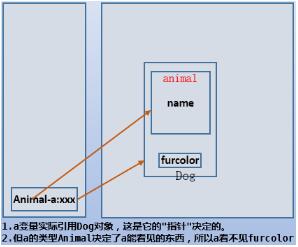您好,登錄后才能下訂單哦!
您好,登錄后才能下訂單哦!
怎么在java中對對象的類型進行轉換?相信很多沒有經驗的人對此束手無策,為此本文總結了問題出現的原因和解決方法,通過這篇文章希望你能解決這個問題。
對象類型轉換
分為向上轉型和向下轉型(強制對象轉型)。 向上轉型是子對象向父對象轉型的過程,例如貓類轉換為動物類;向下轉型是強制轉型實現的,是父對象強制轉換為子對象。 這和基礎數據類型的轉換是類似的,byte在需要時會自動轉換為int(向上轉型),int可以強制轉型為byte(向下轉型)。
對于對象轉型來說, 向上轉型后子對象獨有的成員將不可訪問 。 意思是,在需要一只動物時,可以把貓當作一只動物傳遞,因為貓繼承自動物,貓具有動物的所有屬性。但向上轉型后,貓不再是貓,而是被當作動物看待,它自己獨有的屬性和方法就不可見了。換句話說,向上轉型后,只能識別父對象中的內容。
可以通過"引用變量 instanceof 類名"的方式來判斷引用變量 所指向的對象 是否屬于某個類,也就是說"對象是不是某類",例如聲明一個貓類對象的引用"Cat c",然后"c instanceof Animal"表述的意思是"對象c是一種動物嗎?"對于instanceof返回true的對象,都可以轉換為類對象,只不過有些可能需要強制轉換。
向上轉型可以自動進行,這本就是符合邏輯的,狗類繼承自動物類,它本身就是一只動物,因此在需要動物類的時候,丟一只狗過去就會自動向上轉型成動物類。但這時狗已經不是狗,而是動物,所以狗獨有的成員不再可見。
強制轉換的方式和基礎數據類型強制轉換一樣,都是在待轉換對象前加上目標類型,例如將動物a強制轉換為狗d: Dog d = (Dog)a 。
下面是一個對象類型轉換的示例,很好地分析了能否轉型、轉型后能否訪問某些成員等等。
class Animal {
String name;
Animal(String name) {this.name = name;}
}
class Cat extends Animal {
String eyecolor;
Cat(String name,String color) {super(name); this.eyecolor = color;}
}
class Dog extends Animal {
String furcolor;
Dog(String name,String color) {super(name); this.furcolor = color;}
}
public class OCast {
public static void main(String [] args) {
Animal a = new Animal("animal");
Cat c = new Cat("cat","blue");
Dog d = new Dog("dog","black");
System.out.println( a instanceof Animal);//return true
System.out.println( c instanceof Animal);//return true
System.out.println( d instanceof Animal);//return true
System.out.println( a instanceof Cat); //return false
System.out.println(a.name); //return animal
a = new Dog("yellowdog","yellow"); //object Dog upcast to Animal
System.out.println(a.name); //return yellowdog
System.out.println(a instanceof Animal); //return true
System.out.println(a instanceof Dog); //return true
//System.out.println(a.furcolor); //error! because a was regarded as Animal
Dog d1 = (Dog)a; // because "a instanceof Dog" is true,so force cast Animal a to Dog
System.out.println(d1.furcolor); //return yellow
}
}對于上面的 a = new Dog("yellowdog",yellow) ,a是Animal類型,但此時 它指向的是Dog對象。也就是說它是Dog,所以也是Animal類 ,所以 a instanceof Animal); 和 a instanceof Dog; 都是true,這是它的"指針"決定的。 但因為它的類型是Animal類型,類型決定了能存儲什么樣的數據,對于已經存在的但不符合類型的數據都是不可見的,所以Animal類型決定了它只能看到Dog對象中的Animal部分 。
如下圖:

既然可以向上轉型,配合instanceof的邏輯判斷,就能實現很好的擴展性。例如,動物類的sing(Animal a)方法需要的是一個動物類,可以給它一只狗d,這時會向上轉型(就像需要double類型卻給了一個int數據一樣),雖然轉型了,但狗d的實際引用仍然是Dog對象,于是 if (a instanceof Dog) 判斷為真,則調用能體現狗sing()方法特殊性的語句。如果傳遞一只貓,if判斷一下并調用能體現貓sing()方法特殊性的語句。這樣,任何時候想添加一只動物,都只需要增加一條if語句就可以了。
見下面的示例:
class Animal {
String name;
Animal(String name) {
this.name = name;
}
}
class Cat extends Animal {Cat(String name) {super(name);}}
class Dog extends Animal {Dog(String name) {super(name);}}
public class TestCast {
public static void main(String [] args) {
TestCast t = new TestCast();
Animal a = new Animal("animal");
Animal c = new Cat("cat");
Animal d = new Dog("dog");
t.sing(a);t.sing(c);t.sing(d);
}
void sing(Animal a) {
if ( a instanceof Cat) {
Cat cat = (Cat)a;
System.out.println("cat is singing");
} else if(a instanceof Dog) {
Dog dog = (Dog)a;
System.out.println("dog is singing");
} else {
System.out.println("not an instance of animal");
}
}
}如果沒有對象轉型,那么Dog里要定義一次sing(),Cat里也要定義一次sing()。要增加一個動物類,動物類里也還要定義一次sing()。現在就方便多了,直接在sing()方法內部修改if語句就可以了。
注意,上面的sing()方法不屬于Animal或其他子類的方法,而是獨立定義在其他類里進行調用的。
多態
向上轉型雖然在一定程度上提高了可擴展性,但提高的程度并不太高。以向上轉型為基礎,java的多態實現的擴展性更好更方便。
多態也叫動態綁定或后期綁定,它是執行期間進行的綁定,而非編譯期間的綁定(這是靜態綁定或稱為前期綁定)。
多態的原理是:當向上轉型后,調用一個被重寫的方法時,本該調用的是父類方法,但實際上卻會動態地調用子類重寫后的方法。實際上,編譯期間綁定的確實是父類方法,只不過在執行期間動態轉調子類對應方法。
例如,Animal類的sing()方法,Cat和Dog類都重寫了sing()方法。當需要一個Animal對象時,傳遞了一個Cat類,那么將調用Cat的sing()方法。動態綁定的邏輯正如下面的代碼類似:
void sing(Animal a) {
if ( a instanceof Cat) {
Cat cat = (Cat)a;
System.out.println("cat is singing");
} else if(a instanceof Dog) {
Dog dog = (Dog)a;
System.out.println("dog is singing");
} else {
System.out.println("not an instance of animal");
}
}以下是一個多態的例子
class Animal {
private String name;
Animal(String name) {this.name = name;}
public void sing(){System.out.println("animal sing...");}
}
class Cat extends Animal {
private String eyeColor;
Cat(String n,String c) {super(n); eyeColor = c;}
public void sing() {System.out.println("cat sing...");}
}
class Dog extends Animal {
private String furColor;
Dog(String n,String c) {super(n); furColor = c;}
public void sing() {System.out.println("dog sing...");}
}
class Lady {
private String name;
private Animal pet;
Lady(String name,Animal pet) {this.name = name; this.pet = pet;}
public void myPetSing(){pet.sing();}
}
public class DuoTai {
public static void main(String args[]){
Cat c = new Cat("catname","blue");
Dog d = new Dog("dogname","black");
Lady l1 = new Lady("l1",c);
Lady l2 = new Lady("l2",d);
l1.myPetSing();
l2.myPetSing();
}
}編譯后的執行結果為:
cat sing... dog sing...
在上面的示例中,Lady類的構造方法和她調用sing()方法的代碼為:
Lady(String name,Animal pet) {this.name = name; this.pet = pet;}
public void myPetSing(){pet.sing();}如果構造出Lady對象的pet是Cat對象c,這個c首先會向上轉型為Animal類,也就是說Lady的pet屬性雖然指向的是"Cat c"對象,但它只能看見其中的父對象Animal部分。那么 myPetSing(pet.sing();) 方法自然會調用Animal類的sing()方法。 以上過程是編譯器所認為的過程,也是靜態綁定或前期綁定的過程。
但編譯完成后,雖然pet屬性只能看見Animal部分,但實際在執行時pet.sing()卻換轉換為執行c.sing()。就相當于做了一次對象類型強制轉換 Cat petx = (Cat)pet 。 這是動態綁定或后期綁定的過程,也稱為多態。
實際上,對象在被new出來后,它所涉及到的方法都放在code segment內存區中的一個方法列表中,這個列表中包含了子類、父類的方法,只不過有些時候不可見的方法無法去調用。當執行程序時,內部的機制可以從方法列表中搜索出最符合環境的方法并執行它。
實現多態的技術的關鍵點在于:
(1). 定義一個父類引用f,并將其指向子類對象,即進行向上轉型 ;
(2). 重寫父類的方法,并使用父類引用f去引用這個方法。這樣就可以面向父類進行編程 。
正如上面的示例中,將pet定義為Animal類而非具體的子類,并在方法中調用pet.sing()。如此依賴,就無需考慮pet到底是Cat/Dog,在進行功能擴展添加Bird類時,完全不用再修改Lady類的這段代碼。
再例如,父類Animal,子類Dog,方法sing()。
class Animal {public void sing(A);}
class Dog extends Animal {public void sing(B);}
public class Test {
Animal a = new Dog(); //父類引用變量a指向子對象Dog,此時將向上轉型
a.sing(); //使用父類引用變量a引用被重寫的方法sing(),執行時將動態綁定到Dog的sing()
}看完上述內容,你們掌握怎么在java中對對象的類型進行轉換的方法了嗎?如果還想學到更多技能或想了解更多相關內容,歡迎關注億速云行業資訊頻道,感謝各位的閱讀!
免責聲明:本站發布的內容(圖片、視頻和文字)以原創、轉載和分享為主,文章觀點不代表本網站立場,如果涉及侵權請聯系站長郵箱:is@yisu.com進行舉報,并提供相關證據,一經查實,將立刻刪除涉嫌侵權內容。